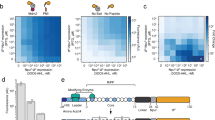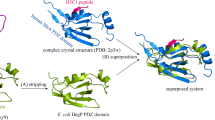Abstract
Periplasmic oligopeptide-binding protein (OppA) is the initial receptor in the ATP-binding cassette (ABC) system of bacteria, which exhibits a broad specificity in binding oligopeptides without regard to sequence. Here, we present a computational study on the structural properties and energetic landscapes of OppA protein interacting with its cognate ligands on the basis of 28 structure/affinity-known OppA–tripeptide complexes. By employing a well-designed protocol that couples the hybrid quantum mechanical/molecular mechanical (QM/MM) scheme and the sophisticated Poisson–Boltzmann/surface area (PB/SA) solvent model together to analyze and decompose the energy components associated with the OppA–peptide binding, we demonstrate that the broad specificity of OppA-recognizing peptides is originated from a series of exquisite balances between the free energy contributions from, for example, the direct nonbonded interactions and indirect desolvation effects, the main chains and side chains, and the different residue positions of the tripeptide ligands. We also show that, in a framework of structure-based quantitative structure–activity relationship (SB-QSAR) methodology, the QM/MM–PB/SA-derived energy terms could be used as a good descriptor to characterize the interaction profile of OppA with peptides and correlate pretty well with the experimentally measured affinities of the binding.






Similar content being viewed by others
References
Alzate-Morales JH, Caballero J, Jague AV, Nilo FDG (2009) Insights into the structural basis of N2 and O6 substituted guanine derivatives as cyclin-dependent kinase 2 (CDK2) inhibitors: prediction of the binding modes and potency of the inhibitors by docking and ONIOM calculation. J Chem Inf Model 49:886–899
Berman HM, Westbrook J, Feng Z, Gilliland G, Bhat TN, Weissig H, Shindyalov IN, Bourne PE (2000) The protein data bank. Nucleic Acids Res 28:235–242
Comell WD, Cieplak P, Bayly CI, Kollman PA (1993) Application of RESP charges to calculate conformational energies, hydrogen bond energies, and free energies of solvation. J Am Chem Soc 115:9620–9631
Cornell WD, Cieplak P, Bayly CI, Gould IR, Merz KM Jr, Ferguson DM, Spellmeyer DC, Fox T, Caldwell JW, Kollman PA (1995) A second generation force field for the simulation of proteins, nucleic acids, and organic molecules. J Am Chem Soc 117:5179–5197
Dannenberg JJ (1997) Hydrogen bonds: a comparison of semiempirical and ab initio treatments. J Mol Struct 401:279–286
Davies TG, Hubbard RE, Tame JR (1999) Relating structure to thermodynamics: the crystal structures and binding affinity of eight OppA–peptide complexes. Protein Sci 8:1432–1444
Duan Y, Wu C, Chowdhury S, Lee MC, Xiong G, Zhang W, Yang R, Cieplak P, Luo R, Lee T, Caldwell J, Wang J, Kollman P (2003) A point-charge force field for molecular mechanics simulations of proteins based on condensed phase quantum mechanical calculations. J Comput Chem 24:1999–2012
Eisenberg D, McLachlan AD (1986) Solvation energy in protein folding and binding. Nature 319:199–203
Frisch MJ, Trucks GW, Schlegel HB, Scuseria GE, Robb MA, Cheeseman JR, Zakrzewski VG, Montgomery JA Jr, Stratmann RE, Burant JC, Dapprich S, Millam JM, Daniels AD, Kudin KN, Strain MC, Farkas O, Tomasi J, Barone V, Cossi M, Cammi R, Mennucci B, Pomelli C, Adamo C, Clifford S, Ochterski J, Petersson GA, Ayala PY, Cui Q, Morokuma K, Malick DK, Rabuck AD, Raghavachari K, Foresman JB, Cioslowski J, Ortiz JV, Stefanov BB, Liu G, Liashenko A, Piskorz P, Komaromi I, Gomperts R, Martin RL, Fox DJ, Keith T, Al-Laham MA, Peng CY, Nanayakkara A, Gonzalez C, Challacombe M, Gill PMW, Johnson BG, Chen W, Wong MW, Andres JL, Head-Gordon M, Replogle ES, Pople JA (2003) Gaussian 03. Gaussian Inc., Wallingford
Guyer CA, Morgan DG, Staros JV (1986) Binding specificity of the periplasmic oligopeptide-binding protein from Escherichia coli. J Bacteriol 168:775–779
Higgins CF (1992) ABC transporters: from microorganisms to man. Annu Rev Cell Biol 8:67–113
Hou T, Zhang W, Case DA, Wang W (2008) Characterization of domain–peptide interaction interface: a case study on the amphiphysin-1 SH3 domain. J Mol Biol 376:1201–1214
Kollman PA, Massova I, Reyes C, Kuhn B, Huo SH, Chong L, Lee M, Duan Y, Wang W, Donini O, Cieplak P, Srinivasan J, Case DA, Cheatham TE (2000) Calculating structures and free energies of complex molecules: combining molecular mechanics and continuum models. Acc Chem Res 33:889–897
Li Y, Yang Y, He P, Yang Q (2009) QM/MM study of epitope peptides binding to HLA-A*0201: the roles of anchor residues and water. Chem Biol Drug Des 74:611–618
Lu Y, Shi T, Wang Y, Yang H, Yan X, Luo X, Jiang H, Zhu W (2009) Halogen bonding—a novel interaction for rational drug design. J Med Chem 5:2854–2862
Monnet V (2003) Bacterial oligopeptide-binding proteins. Cell Mol Life Sci 60:2100–2114
Picon A, Kunji ER, Lanfermeijer FC, Konings WN, Poolman B (2000) Specificity mutants of the binding protein of the oligopeptide transport system of Lactococcus lactis. J Bacteriol 182:1600–1608
Rocchia W, Alexov E, Honig B (2001) Extending the applicability of the nonlinear. Poisson–Boltzmann equation: multiple dielectric constants and multivalent ions. J Phys Chem 105:6507–6514
Rostom RA, Tame JRH, Ladbury JE, Robinson CV (2000) Specificity and interactions of the protein OppA: partitioning solvent binding effects using mass spectrometry. J Mol Biol 296:269–279
Sanner MF, Olson AJ, Spehner JC (1996) Reduced surface: an efficient way to compute molecular surfaces. Biopolymers 38:305–320
Sitkoff D, Sharp KA, Honig B (1994) Accurate calculation of hydration free energies using macroscopic solvent models. J Phys Chem 9:1978–1988
Sleigh SH, Tame JRH, Dodson EJ, Wilkinson AJ (1997) Peptide binding in OppA, the crystal structures of the periplasmic oligopeptide binding protein in the unliganded form and in complex with lysyllysine. Biochemistry 36:9747–9758
Sleigh SH, Seavers PR, Wilkinson AJ, Ladbury JE, Tame JRH (1999) Crystallographic and calorimetric analysis of peptide binding to OppA protein. J Mol Biol 291:393–415
Svensson M, Humbel S, Froese RDJ, Matsubara T, Sieber S, Morokuma K (1996) ONIOM: a multilayered integrated MO + MM method for geometry optimizations and single point energy predictions. A test for Diels-Alder reactions and Pt(P(t-Bu)(3))(2) + H-2 oxidative addition. J Phys Chem 100:19357–19363
Tame JRH, Murshudov GN, Dodson EJ, Neil TK, Dodson GG, Higgins CF, Wilkinson AJ (1994) The structural basis of sequence-independent peptide binding by OppA protein. Science 264:1578–1581
Tame JRH, Dodson EJ, Murshudov GN, Higgins CF, Wilkinson AJ (1995) The crystal structures of the oligopeptide-binding protein OppA complexed with tripeptide and tetrapeptide ligands. Structure 3:1395–1406
Tame JRH, Sleigh SH, Wilkinson AJ, Ladbury JE (1996) The role of water in sequence-independent ligand binding by an oligopeptide transporter protein. Nat Struct Biol 3:998–1001
Wang J, Wolf RM, Caldwell JW, Kollman PA, Case DA (2004) Developing and testing of a general amber force field. J Comput Chem 25:1157–1174
Wold S, Sjöström M, Eriksson L (2001) PLS regression: a basic tool of chemometrics. Chemom Intell Lab Syst 58:109–130
Word JM, Lovell SC, Richardson JS, Richardson DC (1999a) Asparagine and glutamine: using hydrogen atom contacts in the choice of side-chain amide orientation. J Mol Biol 285:1735–1747
Word JM, Lovell SC, LaBean TH, Taylor HC, Zalis ME, Presley BK, Richardson JS, Richardson DC (1999b) Visualizing and quantifying molecular goodness-of-fit: small-probe contact dots with explicit hydrogen atoms. J Mol Biol 285:1711–1733
Yan S, Wu M, Patel DJ, Geacintov NE, Broyde S (2003) Simulating structural and thermodynamic properties of carcinogen-damaged DNA. Biophys J 84:2137–2148
Zhao Y, Cheng T, Wang R (2007) Automatic perception of organic molecules based on essential structural information. J Chem Inf Model 47:1379–1385
Zhou P, Tian F, Li Z (2007) A structure-based, quantitative structure–activity relationship approach for predicting HLA-A*0201-restricted cytotoxic T lymphocyte epitopes. Chem Biol Drug Des 69:56–67
Zhou P, Zou J, Tian F, Shang Z (2009a) Fluorine bonding—how does it work in protein–ligand interactions? J Chem Inf Model 49:2344–2355
Zhou P, Tian F, Lv F, Shang Z (2009b) Comprehensive comparison of eight statistical modelling methods used in quantitative structure–retention relationship studies for liquid chromatographic retention times of peptides generated by protease digestion of the Escherichia coli proteome. J Chromatogr A 1216:3107–3116
Zhou P, Lv J, Zou J, Tian F, Shang Z (2010a) Halogen–water–hydrogen bridges in biomolecules. J Struct Biol 169:172–182
Zhou P, Ren Y, Tian F, Zou J, Shang Z (2010b) Halogen-ionic bridges: do they exist in the biomolecular world? J Chem Theory Comput. doi:10.1021/ct100167w (in press)
Acknowledgments
This work was supported by the Natural Science Foundation Project of Chongqing CSTC (Grant No. 2009BA5068) and the Innovative Talent Training Project, Third Stage of ‘211Project’, Chongqing University (Grant No. S-09104).
Author information
Authors and Affiliations
Corresponding authors
Rights and permissions
About this article
Cite this article
Tian, F., Yang, L., Lv, F. et al. Why OppA protein can bind sequence-independent peptides? A combination of QM/MM, PB/SA, and structure-based QSAR analyses. Amino Acids 40, 493–503 (2011). https://doi.org/10.1007/s00726-010-0661-9
Received:
Accepted:
Published:
Issue Date:
DOI: https://doi.org/10.1007/s00726-010-0661-9




